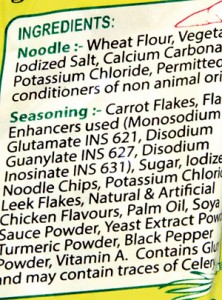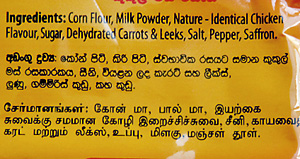News
MSG: The ‘other’ taste that makes a difference

Dr. Waruna Gunathilake Pix by M.A. Pushpa Kumara
In the eye of the storm is monosodium glutamate (MSG), with the international jury over the years being sharply divided whether it is good or bad. While some international experts have given MSG, a flavour-enhancer, a clean bill of health, others have condemned it as causing serious illness.
Sri Lanka has been pushed into looking closely at MSG, as India banned Maggi noodles, a product of multinational Nestle, with regulators taking issue about the non-mention of MSG on the packs of this popular snack produced by Nestle India. Testing had also allegedly found samples to contain lead, a heavy metal, in excess of the prescribed limit.
A round of calls locally to check whether any institution including the Industrial Technology Institute (ITI) has tested MSG came up negative. However, the Consumer Affairs Authority’s Director-General J.M.A. Douglas told the Sunday Times that they were in the process of collecting samples, not only of instant noodles but also of koththu rotti of different brands to be sent for testing abroad.
 Many doctors, when contacted by the Sunday Times, voiced concern over MSG, reiterating that, in excess MSG may not be good for the health. They pointed out that, in Sri Lanka everything and anything is being laced with MSG. “The problem is that we simply don’t test our foods for MSG,” a doctor said, adding that, although it is said to be in Chinese restaurant food and processed food as well as instant soups and soup-cubes, sauces and dressings and canned food, it is sprinkled lavishly into fast food, short-eats such as cutlets, rolls and pastries and even vadai etc.
Many doctors, when contacted by the Sunday Times, voiced concern over MSG, reiterating that, in excess MSG may not be good for the health. They pointed out that, in Sri Lanka everything and anything is being laced with MSG. “The problem is that we simply don’t test our foods for MSG,” a doctor said, adding that, although it is said to be in Chinese restaurant food and processed food as well as instant soups and soup-cubes, sauces and dressings and canned food, it is sprinkled lavishly into fast food, short-eats such as cutlets, rolls and pastries and even vadai etc.
Nothing is spared, the Sunday Times understands, with potato, manioc and sweet potato chips and items such as sausages and burgers also being sprinkled with MSG. Another doctor was critical of the system as there are no checks, allowing big and small eateries alike to use MSG with impunity. “When I eat from a reputed food producer which has outlets selling short-eats everywhere, I come out in blisters. This alerts me that this producer is using MSG,” he said.
 One researcher who pointed out that MSG is even being mixed into the humble pol-sambol, turned to international research to explain that MSG has been implicated in causing chronic allergies in some susceptible people.Studies on mice have also shown that fatty liver and metabolic derangement are caused by MSG, the researcher said, adding that, in laboratories in other countries when there is a need to study mice models with metabolic syndrome, the mice are fed MSG. This is a danger signal because, in Sri Lanka, currently there is an issue with numerous people having fatty liver which is definitely linked to eating habits.
One researcher who pointed out that MSG is even being mixed into the humble pol-sambol, turned to international research to explain that MSG has been implicated in causing chronic allergies in some susceptible people.Studies on mice have also shown that fatty liver and metabolic derangement are caused by MSG, the researcher said, adding that, in laboratories in other countries when there is a need to study mice models with metabolic syndrome, the mice are fed MSG. This is a danger signal because, in Sri Lanka, currently there is an issue with numerous people having fatty liver which is definitely linked to eating habits.
 “May be we should conduct studies to confirm whether MSG in our food is one of the contributory factors for fatty liver, with the increasing trend of people eating out most of the time,” the researcher said, adding that more people are also using it in their home-cooking.
“May be we should conduct studies to confirm whether MSG in our food is one of the contributory factors for fatty liver, with the increasing trend of people eating out most of the time,” the researcher said, adding that more people are also using it in their home-cooking.
It is Dr. Waruna Gunathilake, Head of the Toxicology & National Poisons Information Centre based at the National Hospital in Colombo, who unearths reams and reams of research both for and against MSG. Referring to research from across the world, he cites one warning which states that although MSG has been used as a food additive for decades and the United States Food and Drug Administration (FDA) has classified it as a food ingredient that is “generally recognised as safe”, the FDA “requires” that it be listed on the label.
Anecdotal reports of adverse reactions to foods containing MSG received by the FDA include headache, flushing, sweating, facial pressure or tightness, numbness, tingling or burning in the face, neck and other areas, heart palpitations, chest pain, nausea and weakness, says Dr. Gunathilake, explaining that they are called ‘MSG symptom complex’.
Although the European Union too has classified MSG as a food additive, there are regulations to determine how and when it can be added to foods, he points out. On the other hand, other writers have asked why if MSG is bad, everyone in Asia has no headache, because in this region it is used in most food.
It was in Japan, more than a century ago, that Prof. Kidunae Ikeda, a biochemistry specialist, stumbled on MSG. Relishing a vegetable broth his wife had prepared, he found that her secret was the addition of dried seaweed, an internet search reveals.
Other researchers, meanwhile, have highlighted the negatives of this additive, as far back as 1960. A doctor had written to The New England Journal of Medicine that every time he ate from a Chinese restaurant there was an allergic reaction, referring to the collection of symptoms as ‘Chinese Restaurant Syndrome’ (CRS), although it had not been confirmed whether it was due to MSG, the wine he drank or the spices in the food.

Sri Lanka has been pushed into looking closely at MSG, as India banned Maggi noodles, with regulators taking issue about the non-mention of MSG on the packs of this popular snack produced by Nestle India.
A neuroscientist who had injected the additive to white laboratory mice had found that it led to the animals suffering neurological problems including brain lesions or impaired development. Much later in 1994, researchers found that MSG penetrated placental barriers and caused transplacental neurotoxic effects on structures and functions of specific brain areas of filial mice, says Dr. Gunathilake who has done an extensive literature search on MSG.
In an in-depth piece in 2009 on MSG titled ‘MSG: Is this silent killer lurking in your kitchen cabinets’, a US board-certified Neurosurgeon, Dr. Russell Blaylock, is quoted as saying that MSG is an excitotoxin. This means that MSG “overexcites to the point of damage or death, causing brain damage to varying degrees – and potentially even triggering or worsening learning disabilities, Alzheimer’s disease, Parkinson’s disease, Lou Gehrig’s disease and more”
It further states that part of the problem also is that free glutamic acid is the same neurotransmitter that the brain, nervous system, eyes, pancreas and other organs use to initiate certain processes in the body. It quotes the FDA as stating: “Studies have shown that the body uses glutamate, an amino acid, as a nerve impulse transmitter in the brain and that there are glutamate-responsive tissues in other parts of the body as well. Abnormal function of glutamate receptors has been linked with certain neurological diseases such as Alzheimer’s disease and Huntington chorea. Injections of glutamate in laboratory animals have resulted in damage to nerve cells in the brain.”
Other medical research also indicates that MSG may be linked to childhood obesity and the development of diabetes, says Dr. Gunathilake, stressing that in view of the challenge of an epidemic of non-communicable diseases (NCDs) that the country is confronted with, Sri Lanka needs to take a hard and close look at the use of MSG.
In the light of the debate whether or not MSG is good or bad, Dr. Gunathilake advises the public to be safe now than sorry later. “What we know for sure is that anything in excess is bad, so try and cut out MSG as much as possible from your diet.”
| What’s in a name? To the palate it’s all the same MSG comes masked under different names. So if you are a scrutiniser of labels, as everyone should be, here is what you need to look for, says Dr. Waruna Gunathilake. Food which contains MSG may indicate that it has ‘E/INS621′.According to experts, the following ‘always’ contains MSG: n Autolyzed yeast, glutamate, monopotassium glutamate, textured protein, yeast nutrient, calcium caseinate, glutamic acid, yeast extract, gelatin, hydrolyzed protein, sodium caseinate and yeast food. The following ‘often’ contains MSG or creates MSG during processing: | |
| It came in with the tide, as old as time While working on experiments on seaweed which would later enable him to produce glutamic acid synthetically, Prof. Kidunae Ikeda also came up with another ‘taste’ different to the four primary tastes of ‘sweet’, ‘sour’, ‘bitter’ and ‘salty’. This, he had claimed, was similar to the taste found in “asparagus, tomatoes, cheese and meat” and called it ‘umami’ (savoury). By 1909, he was able to isolate the chemical with the molecular formula C5H9NO4, the properties of which were similar to glutamic acid, says Dr. Gunathilake, explaining that this is an amino acid produced by the human body and also found in high-protein food such as dairy products, meat, fish and many vegetables. It is then that Prof. Ikeda had announced that his study found two facts – the broth of seaweed contains glutamate (the result of the breaking down of the protein containing glutamic acid) and that glutamate brings out the ‘savoury’ taste. Stabilizing the chemical by mixing it with salt and water brought forth the white crystals of monosodium glutamate (MSG), which Prof. Ikeda marketed as ‘Aji-no-moto’ (the essence of taste), says Dr. Gunathilake, adding that now MSG is produced through an industrial fermentation process. | |

